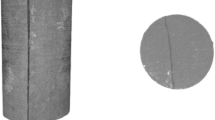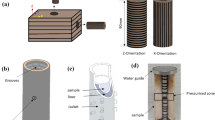Abstract
We measured argon gas permeability in three intact and one partially fractured Eagle Ford Shale samples documenting the stress dependence of horizontal (bedding parallel) in situ permeability of intact samples which varies between 1 and 10 nD (1 nD = 0.9869233 × 10−21 m2), while the permeability of partially fractured sample varies between 18 and 37 nD. For all samples, permeability decreases by up to an order of magnitude while cycling the confining pressure (PC) between 27.7 and 55.2 MPa at a constant pore pressure (PP) of 14.4 MPa. Most of the permeability decrease is within the first loading and unloading cycle. During this first cycle, we also observe less than 2% decline in permeability over ~ 10 days when we held the PC constant at 51.6–55.2 MPa, respectively. This suggests that the ongoing creep plays a relatively minor role. The subsequent PC cycles result in a small decrease in permeability (~ 6 to 26% variation between the start and the end of each cycle). We interpret that the initial permeability loss is due to the closing of micro-fractures—which we infer are caused by stress relief and gas expansion during sample retrieval and/or preparation. We interpret that the higher permeability of the partially fractured sample is mainly due to incomplete closure of a preexisting fracture, which extends nearly two-third the sample length. We document this dual-permeability structure from the observation of a dual-timescale pressure response behavior during the experiments at lower PC–PP. We find permeability decreases with increasing PC–PP; stress dependency of permeability follows an exponential relationship with a stress-sensitive gradient of 0.019–0.040 MPa−1. A better understanding of permeability variation with stress will help to reliably estimate in situ permeability and to better understand production evolution from unconventional shale reservoirs.










Similar content being viewed by others
References
Achang, M., Pashin, J.C., Cui, X.: The influence of particle size, microfractures, and pressure decay on measuring the permeability of crushed shale samples. Int. J. Coal Geol. 183, 174–187 (2017). https://doi.org/10.1016/j.coal.2017.09.012
Alnoaimi, K.R., Kovscek, A.R.: Experimental and numerical analysis of gas transport in shale including the role of sorption: SPE paper 166375. In: SPE Annual Technical Conference and Exhibition Held in New Orleans, Louisiana, USA, pp. 1–16 (2013)
Armitage, P.J., Faulkner, D.R., Worden, R.H., Aplin, A.C., Butcher, A.R., Iliffe, J.: Experimental measurement of, and controls on, permeability and permeability anisotropy of caprocks from the CO2 storage project at the Krechba Field, Algeria. J. Geophys. Res. Solid Earth 116, B12208 (2011). https://doi.org/10.1029/2011JB008385
Behnsen, J., Faulkner, D.R.: Water and argon permeability of phyllosilicate powders under medium to high pressure. J. Geophys. Res. Solid Earth 116, B12203 (2011). https://doi.org/10.1029/2011JB008600
Bertoncello, A., Honarpour, M.M.: Standards for characterization of rock properties in unconventional reservoirs: fluid flow mechanism, quality control, and uncertainties: SPE paper 166470. In: SPE Annual Technical Conference and Exhibition, Society of Petroleum Engineers, New Orleans, Louisiana, USA (2013). https://doi.org/10.2118/166470-ms
Bhandari, A.R., Flemings, P.B., Polito, P.J., Cronin, M.B., Bryant, S.L.: Anisotropy and stress dependence of permeability in the Barnett Shale. Transp. Porous Media 108(2), 393–411 (2015). https://doi.org/10.1007/s11242-015-0482-0
Brace, W.F., Walsh, J.B., Frangos, W.T.: Permeability of granite under high pressure. J. Geophys. Res. 73(6), 2225–2236 (1968). https://doi.org/10.1029/JB073i006p02225
Chenevert, M.E., Amanullah, M.: Shale preservation and testing techniques for borehole-stability studies. SPE Drill. Complet. SPE 73191, 146–149 (2001)
Clarkson, C.R.: Production data analysis of unconventional gas wells: review of theory and best practices. Int. J. Coal Geol. 109–110, 101–146 (2013). https://doi.org/10.1016/j.coal.2013.01.002
Dai, S., Santamarina, J.C.: Sampling disturbance in hydrate-bearing sediment pressure cores: NGHP-01 expedition, Krishna–Godavari Basin example. Mar. Pet. Geol. A 58, 178–186 (2014). https://doi.org/10.1016/j.marpetgeo.2014.07.013
Dicker, A.I., Smits, R.M.: A practical method for determining permeability from laboratory pressure-pulse decay measurements: SPE paper. In: vol. 17578, pp. 285–292 (1988)
EIA: International Energy Outlook 2016. Rep. DOE/EIA-0484(2016), p. 290 (2016)
Firouzi, M., Alnoaimi, K., Kovscek, A., Wilcox, J.: Klinkenberg effect on predicting and measuring helium permeability in gas shales. Int. J. Coal Geol. 123, 62–68 (2014). https://doi.org/10.1016/j.coal.2013.09.006
Grathoff, G.H., Peltz, M., Enzmann, F., Kaufhold, S.: Porosity and permeability determination of organic-rich Posidonia shales based on 3-D analyses by FIB-SEM microscopy. Solid Earth 7(4), 1145–1156 (2016). https://doi.org/10.5194/se-7-1145-2016
Heller, R., Vermylen, J., Zoback, M.: Experimental investigation of matrix permeability of gas shales. AAPG Bull. 98(5), 975–995 (2014). https://doi.org/10.1306/09231313023
Hsieh, P.A., Tracy, J.V., Neuzil, C.E., Bredehoeft, J.D., Silliman, S.E.: A transient laboratory method for determining the hydraulic properties of tight rocks. 1. Theory. Int. J. Rock Mech. Min. Sci. 18(3), 245–252 (1981). https://doi.org/10.1016/0148-9062(81)90979-7
Ilhan, M.A.: Understanding coring operations for shale gas exploration. In: Hill, P.L.D., Curtis, J. (eds.) Gas Shale in the Rocky Mountains and Beyond, pp. 229–239. Rocky Mountain Association of Geologists 2008 Guidebook CD (2008)
Jones, S.C.: A technique for faster pulse-decay permeability measurements in tight rocks. In: SPE Formation Evaluation (SPE 28450), pp. 19–25 (1997)
Klinkenberg, L.J.: The permeability of porous media to liquids and gases. In: Drilling and Production Practices, pp. 200–213 (1941)
Ko, L.T., Loucks, R.G., Ruppel, S.C., Tongwei, Z., Peng, S.: Origin and characterization of Eagle Ford pore networks in the South Texas Upper Cretaceous shelf. AAPG Bull. (2017). https://doi.org/10.1306/08051616035
Kosanke, T., Warren, A.: Geological controls on matrix permeability of the eagle ford shale (cretaceous), South Texas, U.S.A. In: Memoir 110: The Eagle Ford Shale: A Renaissance in U.S. Oil Production, pp. 285–300 (2016)
Letham, E.A., Bustin, R.M.: Klinkenberg gas slippage measurements as a means for shale pore structure characterization. Geofluids 16(2), 264–278 (2016). https://doi.org/10.1111/gfl.12147
Luffel, D.L., Hopkins, C.W., Holditch, S.A., Schetter, P.D.: Matrix permeability measurement of gas productive shales. In: Society of Petroleum Engineers Annual Technical Conference and Exhibition, Houston, Texas. SPE Paper 26633, p. 10 (1993)
Mathur, A., Sondergeld, C.H., Rai, C.S.: Comparison of steady-state and transient methods for measuring shale permeability: SPE paper 180259. In: SPE Low Perm Symposium. Society of Petroleum Engineers, Denver, Colorado, USA (2016). https://doi.org/10.2118/180259-MS
Morrow, C.A., Bo-Chong, Z., Byerlee, J.D.: Effective pressure law for permeability of Westerly Granite under cycling loading. J. Geophys. Res. 91(B3), 3870–3876 (1986)
Peng, S., Loucks, B.: Permeability measurements in mudrocks using gas-expansion methods on plug and crushed-rock samples. Mar. Pet. Geol. 73, 299–310 (2016). https://doi.org/10.1016/j.marpetgeo.2016.02.025
Rosen, R., Mickelson, W., Sharf-Aldin, M., Kurtoglu, B., Kosanke, T., PaiAngle, M. Patterson, R., Mir, F., Narasimhan, S., Amini, A.: Impact of experimental studies on unconventional reservoir mechanisms: SPE paper 168965. In: SPE Unconventional Resources Conference, The Woodlands, Texas (2014)
Rydzy, M.B., Patino, J., Elmetni, N., Appel, M.: Stressed permeability in shales: effects of matrix compressibility and fractures—a step towards measuring matrix permeability in fractured shale samples: SCA paper SCA2016-027. Paper Presented at International Symposium of the Society of Core Analysts, Snowmass, Colorado, USA, 21–26 Aug 2016
Selvadurai, A.P.S., Glowacki, A.: Permeability hysterisis of limestone during isotropic compression. Ground Water 46(1), 113–119 (2008)
Sondergeld, C.H., Newsham, K.E., Comisky, J.T., Rice, M.C., Rai, C.S.: Petrophysical considerations in evaluating and producing shale gas resources: SPE paper 131768. In: SPE Unconventional Gas Conference, Society of Petroleum Engineers, Pittsburgh, Pennsylvania, USA (2010). https://doi.org/10.2118/131768-MS
Teklu, T.W., Li, X., Zhou, Z., Cui, Q., Abass, H.: Fracture and matrix permeability hysteresis in organic rich mudrocks: URTeC paper 2431080. In: Unconventional resources technology conference. Unconventional Resources Technology Conference, San Antonio, Texas, USA (2016). https://doi.org/10.15530/urtec-2016-2431080
Tinni, A., Fathi, E., Agarwal, R., Sondergeld, C., Akkutlu, Y., Rai, C.: Shale permeability measurements on plugs and crushed samples: SPE paper 162235. In: SPE Canadian Unconventional Resources Conference, Calgary, Alberta, Canada (2012)
Walsh, J.B.: Effect of pore pressure and confining pressure on fracture permeability. Int. J. Rock Mech. Min. Sci. Geomech. Abst. 18(5), 429–435 (1981). https://doi.org/10.1016/0148-9062(81)90006-1
Wust, R.A.J., Cui, A., Nassichuk, B., Brezovski, R., Letham, E., Bustin, R.M.: Improved understanding of Gas/Liquid Transport in Unconventional Shales of the Eagle Ford (USA), Montney (Canada), and REM (Australia) through micro-morphological and laboratory analyses of rock fabric and pore sizes: SPE paper 1715134. In: SPE Asia Pacific Oil and Gas Conference, Adeliade, Australia (2014)
Ziarani, A.S., Aguilera, R.: Knudsen’s permeability correction for tight porous media. Transp. Porous Med. 91, 239–260 (2012). https://doi.org/10.1007/s11242-011-9842-6
Zubizarreta, I., Byrne, M., Sorrentino, Y., Rojas, E.: Pore pressure evolution, core damage and tripping out schedules: a computational fluid dynamics approach. In: SPE/IADC 163527 (2013)
Acknowledgements
This research project is funded by Shell under the Shell-UT Unconventional Research (SUTUR) program. We thank Shell for providing the two samples from SW3 well. We thank the Mudrock System Research Laboratory (MSRL) and its sponsors for providing access to the two samples from K2 well. We also thank Lucy T. Ko for the SEM images of the samples from K2 well, Patrick Smith for taking the SEM images of the samples from SW3 well and Dr. Jessica Maisano for taking the microscale X-ray computed tomography images of the test core plugs. We are grateful to Drs. Robert Dombrowski, Mikhail Geilikman, Robert Loucks and Stephen Ruppel for guidance and fruitful discussions.
Author information
Authors and Affiliations
Corresponding author
Electronic supplementary material
Below is the link to the electronic supplementary material.
Rights and permissions
About this article
Cite this article
Bhandari, A.R., Flemings, P.B., Hofmann, R. et al. Stress-Dependent In Situ Gas Permeability in the Eagle Ford Shale. Transp Porous Med 123, 1–20 (2018). https://doi.org/10.1007/s11242-018-1021-6
Received:
Accepted:
Published:
Issue Date:
DOI: https://doi.org/10.1007/s11242-018-1021-6




